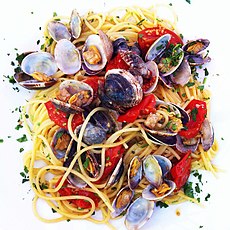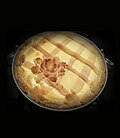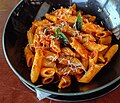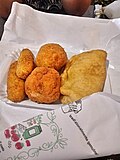 |
| Italian cuisine |
|---|
|
|
Roman cuisine consists of the cooking traditions and practices of the Italian city of Rome. It features fresh, seasonal and simply-prepared ingredients from the Roman Campagna.[1] These include peas, globe artichokes and fava beans, shellfish, milk-fed lamb and goat, and cheeses such as pecorino romano and ricotta.[2] Olive oil is used mostly to dress raw vegetables, while strutto (pork lard) and fat from prosciutto are preferred for frying.[1] The most popular sweets in Rome are small individual pastries called pasticcini, gelato and handmade chocolates and candies.[3] Special dishes are often reserved for different days of the week; for example, gnocchi is eaten on Thursdays, baccalà (salted cod) on Fridays and trippa on Saturdays.
History
[edit]
Rome's food has evolved through centuries and periods of social, cultural and political changes. Rome became a major gastronomical center during the ancient age. Ancient Roman cuisine was mainly based on cereals, cheeses, legumes and fruit.[4] Subsequently, the empire's enormous expansion exposed Romans to many new, provincial culinary habits and cooking techniques. In the beginning, the differences between social classes were not very great, but disparities developed with the empire's growth. Later, during the Italian Renaissance, Rome became well known as a center of high-cuisine, since some of the best chefs of the time worked for the popes. An example of this could be Bartolomeo Scappi, who was a chef working for Pope Pius IV in the Vatican kitchen, reaching fame with his cookbook Opera dell'arte del cucinare, published in 1570. Here he lists approximately 1,000 recipes of Renaissance cuisine and describes cooking techniques and tools, giving the first known picture of a fork.[5] Roman and all Italian cuisine were transformationally influenced by the introduction of new world crops by the Spanish, especially the tomato.
Traditional cucina romana
[edit]The Testaccio rione, Rome's trade and slaughterhouse area, is the place where Rome's most original and traditional foods can still be found. The area was often known as the "belly" or "slaughterhouse" of Rome, and was inhabited by butchers, or vaccinari.[6] The most common or ancient Roman cuisine included the quinto quarto (lit. 'fifth quarter').[6] Popular foods include pig's trotters, brain and the genitals of other animals,[6] which were often carefully cooked and richly spiced with different savouries, spices and herbs. The old-fashioned coda alla vaccinara (oxtail cooked in the way of butchers)[6] is still one of the city's most popular meals and is part of most of Rome's restaurants' menus. Lamb is also a very popular part of Roman cuisine, and is often roasted with spices and herbs.[6] There is a considerable Jewish influence in Roman cuisine, since many Jews lived in the city, and some of the traditional meals of the ghetto date back over 400 years. Such include the carciofi alla giudia[7] (Jewish-style artichokes) and the pizza dolce di Beridde.
Pasta in Rome
[edit]Pasta is one important element of Roman cuisine. Famous Roman pasta dishes include cacio e pepe (cheese and black pepper), gricia (a sauce made with guanciale and hard cheese, typically pecorino romano), carbonara (like gricia but with the addition of egg) and amatriciana (like gricia but with the addition of tomato). Fettuccine Alfredo (invented in Rome by the chef of restaurant Alfredo alla Scrofa) is famous abroad, but not considered traditional and mostly unheard of in Rome.
There used to be a pasta museum in Rome called "Museo Nazionale della Paste Alimentari",[6] but now there is a hotel there. Rome's most common pasta shape is spaghetti, but there are many other forms.[6]
Beverages
[edit]The city is known as a center of white wine. Frascati and Roman Castles have been called the best ones in the city.[8]
Desserts
[edit]There are also many desserts and sweets in Roman cuisine, many of which are made with ricotta cheese. Typical of Rome is the grattachecca, a type of shaved ice.[6]
Dishes
[edit]| Name | Image | Description |
|---|---|---|
| Abbacchio alla romana[9] |  |
|
| Bucatini all'amatriciana[10] |  |
|
| Bruschetta |  |
|
| Cacio e pepe |  |
|
| Carbonara |  |
|
| Carciofi alla giudia[11] |  |
|
| Carciofi alla romana[11] |  |
|
| Coda alla vaccinara |  |
|
| Coppiette | stripes of dried meat (pork or horse), usually spicy | |
| Crostata di ricotta[6] |  |
|
| Fiori di zucca |  |
zucchini flowers filled with mozzarella and anchovies, battered and deep-fried |
| Gnocchi alla romana |  |
|
| Maritozzi |  |
|
| Pasta alla gricia |  |
|
| Penne all'arrabbiata |  |
|
| Rigatoni con la pajata[12] |  |
|
| Saltimbocca alla romana[13] |  |
|
| Scaloppine alla romana |  |
|
| Supplì |  |
|
| Trippa alla romana[14] |  |
See also
[edit]![]() Media related to Cuisine of Rome at Wikimedia Commons
Media related to Cuisine of Rome at Wikimedia Commons
References
[edit]- ^ a b Boni (1930), p. 13
- ^ Boni (1930), p. 14
- ^ Eats, Serious. "Gina DePalma's Guide To Rome Sweets". sweets.seriouseats.com. Retrieved 14 November 2017.
- ^ "Cucina Antica Roma E Ricette Romane" (in Italian). Retrieved 21 October 2021.
- ^ Rolland, Jacques (2006). The food encyclopedia. Toronto: Robert Rose. p. 273. ISBN 0-7788-0150-0. OCLC 70176309.
- ^ a b c d e f g h i Eyewitness Travel (2006), pg. 312 - 313
- ^ https://www.buttalapasta.it/ricette/ricette-carciofi-alla-giudia/23845/
- ^ Eyewitness Travel (2006), pg. 314 - 315
- ^ "Abbacchio alla romana" (in Italian). Retrieved 8 January 2024.
- ^ Boni (1930), p. 44
- ^ a b Boni (1930), p. 156
- ^ Boni (1930), p. 150
- ^ Boni (1930), p. 96
- ^ Boni (1930), p. 94
Bibliography
[edit]- Boni, Ada (1983) [1930]. LaCucina Romana (in Italian). Roma: Newton Compton Editori.
- Carnacina, Luigi; Bonassisi, Vincenzo (1975). Roma in Cucina (in Italian). Milano: Giunti Martello.
- Malizia, Giuliano (1995). La Cucina Ebraico-Romanesca (in Italian). Roma: Newton Compton Editori.
- Rome. Eyewitness Travel. DK Publishing. 2006. ISBN 1-4053-1090-1.